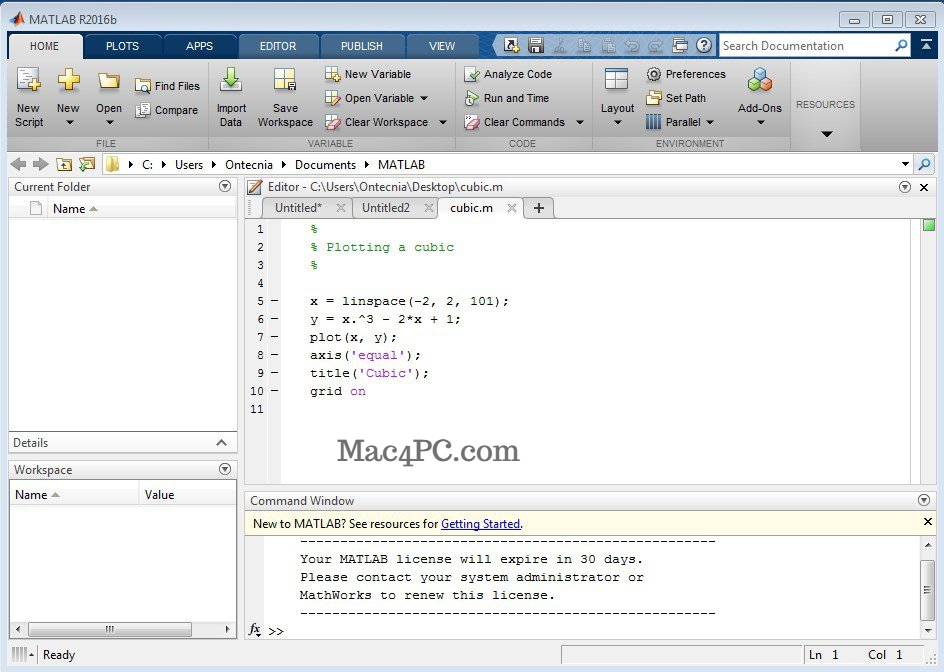

- MATLAB 2012 MAC DOWNLOAD HOW TO
- MATLAB 2012 MAC DOWNLOAD MAC OS X
- MATLAB 2012 MAC DOWNLOAD DRIVER
- MATLAB 2012 MAC DOWNLOAD CODE
The LabJackPython Examples/ directory has a file named u3allio.py that can measure the same thing: So in this case it runs at 1.2 ms, but with a good, powered hub it can go to 0.6 ms. Here's after I plug in a crappy un-powered hub: That is, we can generally get about 0.6 ms with a hub and about 4 ms without a hub. In LabJackPython we can get times consistent with Section 3.1 of the U3 User's Guide. I'll try the same in LabJackPython and see if it is any faster. Now of course my FTDI doesn't do all the cool things the LabJack does, but just wondered as 1.6ms is higher than you have measured.

One other thing I noticed (this is on a high speed hub on a high speed port) when running via the command line, if I toggle FIO4 a thousand times in a tight loop and divide total time by number of switches, I get about a 1.6ms to switch between levels, and about 0.4ms doing the same on a FTDI USB -> serial. I've attached the crashlogs for 3 representative crashes. I meant optimism for tracking down the problem. Not too much as all our production machines stil use OS X As this is a perennial problem for researchers using Macs, may also be an interesting place to post it. Once I get the interface set up and working (maybe delayed a bit by other lab projects!), I'll post the Matlab wrapper class to github, and will contribute it to the Psychophysics toolbox (which will have to be cross-platform with windows). Sadly I left the U3 at work so won't be able to play till next week, however your post is incredibly helpful. This is wonderful stuff, I love the Python interface, so elegant to have such a robust cross-platform tool.
MATLAB 2012 MAC DOWNLOAD MAC OS X
We'd like to know about more Mac OS X customers using their LabJacks with Matlab. Your application seems simple enough that you could hide the low level bytes to send in one or two functions. It's a low-level interface, but it's very efficient, and it's explicit about what it's doing. So to set FIO4 to output high from Matlab, all you would have to do is have a function that calls LJUSB_Write() with these bytes:Īnd then call LJUSB_Read() to read 10 bytes, which you can ignore since they don't tell you much. In the feedback command, we're sending BitDirWrite to set FIO4 to output, and BitStateWrite to set FIO4's state to high.
MATLAB 2012 MAC DOWNLOAD CODE
In the code above, we're sending a feedback command which is documented in Section 5.2.5 of the U3 User's Guide.

> d.getFeedback( u3.BitDirWrite(4, 1), u3.BitStateWrite(4, 0) ) > d.getFeedback( u3.BitDirWrite(4, 1), u3.BitStateWrite(4, 1) ) To set FIO4 to be output high and then output low: It is a great way to see the bytes coming and going to the U3. To know what bytes to write to the U3, we recommend grabbing a copy of LabJackPython. In your case, it sounds easier to us to just send the bytes your self rather than rely on the C code. We've never done this, so we don't know if it would work. If you know how you may be able to call eDO from u3.h if you build u3.c as a library and load it into Matlab.
MATLAB 2012 MAC DOWNLOAD DRIVER
The UD driver has those functions built-in, the Exodriver has implementations in user application code. This is the difference between the Exodriver and the UD driver. There's a u3.h that implements the UD driver "e-" functions.
MATLAB 2012 MAC DOWNLOAD HOW TO
There are lots of examples of how to do this C in and Python. You use Section 5 of the U3 User's Guide to build the commands the U3 expects. A minimal program works something like this:Ģ. It provides 4 primary functions: Open, Write, Read, and Close. The Exodriver is a thin layer around the hardware (think exoskeleton). In our limited Matlab experience, you finished the hardest part.ĭoes the exodriver provide the same functionality as the labjackUD (it has many more fucntions listed by matlab)? Hi, just received our testing U3, and I can succesfully use loadlib in matlab to load the exodriver:


 0 kommentar(er)
0 kommentar(er)
